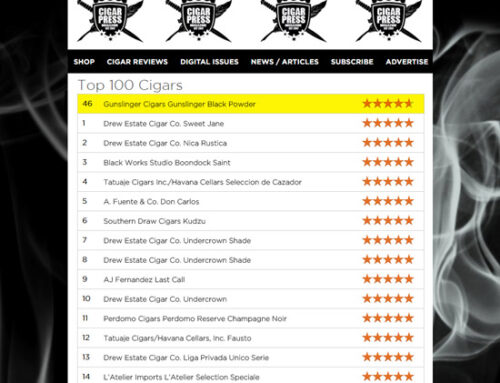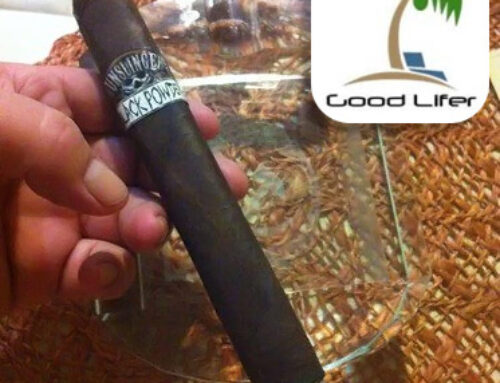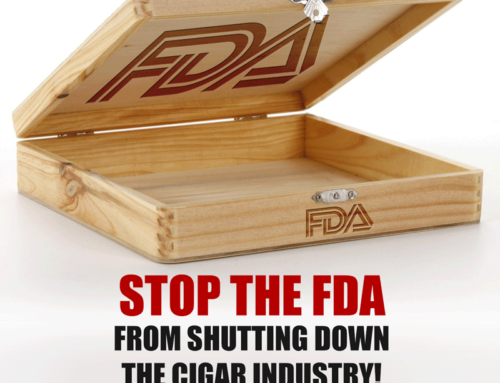8-9-8 – Cigars in a standard box with eight cigars on top, nine in the middle, and eight on the bottom.
Accordion bunch – A bunching technique where the edges of the leaf are folded inward, then the folded leaves are stacked one on top of the other before rolling up the bunch and securing it with a binder leaf. The folds allow for more air flow through the cigar.
Acidic – A ph of less than 7. Acidic tobacco will have a slightly sour taste, Cigarette tobacco is considered acidic.
Active humidifier – A humidification system that employs fans and programmable set points for humidity. A reservoir holds purified water that the fans disperse in a fine mist in the humidor.
Air-Curing – The method of curing tobacco used for cigar tobacco. The leaves are hung in curing barns after harvest for about two months during which time lose most of their moisture and chlorophyll.
Band-A ring of paper wrapped around the closed head of most cigars. Legend says that cigar bands were invented by Catherine the Great or by Spanish nobles to keep their gloves from being stained. Others credit this invention to a Dutch advertising and promotion genius named Gustave Bock, who stated that the band helped keep the cigar wrapper together. Cigar bands are often printed with the name of the brand, country of origin, and/or indication that the cigar is hand-rolled. They also often have colorful graphics, which have made them popular collectors’ items.
Binder-The portion of a tobacco leaf used to hold together the blend of filler leaves called the bunch; with the wrapper and filler, it is one of three main components in a cigar.
Blend-The mixture of different types of tobacco in a cigar, including up to five types of filler leaves, a binder leaf and an outer wrapper.
Blue Mold-Peronospora tabacina is a fast moving, airborne fungus that can ruin a tobacco field in just a few days. It flourishes in cool, cloudy weather with light rain and riddles tobacco leaves with small round blemishes.
Booking-A rolling method by which the cigarmaker lays the filler leaves atop one another, then rolls them up like a scroll. Book style, or booking, is common in Honduras.
Bouquet-The smell, or nose (as in the wine term) of a fine cigar. Badly stored cigars or cigars that have dried-out too much will lose their bouquet.
Box-The container used to package cigars. There are several traditional styles:Cabinet Selection refers to wood boxes with a sliding top, designed to hold 25 or 50 cigars. 8-9-8 refers to a round-sided box specifically designed to accommodate three rows of cigars eight on top, nine in the middle, eight on the bottom. Flat Top, or 13-topper, is the flat rectangular box most popular today, with 13 cigars on top and 12 on the bottom divided by a cedar block spacer.
Bunch-Up to four different types of filler tobacco that are blended to create the body of the cigar. The bunch is held together by the binder.
Cabinet Selection-Cigars packed in a wooden box rather than the standard cardboard or paper-covered cigar boxes. These are preferable when buying cigars for aging. Many cabinet selection cigars are often packaged without protective cellophane outer wrappers.
Cameroon-A wrapper leaf grown primarily in Cameroon, West Africa, preferred by cigar smokers for their delicately spicy taste, sweet aroma, excellent burning properties and similarity to native Cuban wrappers.
Candella-A bright green shade of wrapper, achieved by a heat-curing process that fixes the chlorophyll content of the wrapper while it’s still in the barn. Also referred to as double claro or jade.
Canoeing-When a cigar burns unevenly or at an extreme angle, producing a canoe-like ash in which a section of the wrapper does not ash. To prevent this, it helps to rotate the cigar often and let it rest. Biting down too hard on your cigar can affect the draw and may also cause canoeing.
Cap-A circular piece of wrapper leaf placed at the head of the cigar to secure the wrapper.
Capa-The cigars wrapper. This term is mainly used when refering to a cigar that has 2 wrappers “Dos Capa’s”. Generally the cigar has a barberpole style wrap, usually a light leaf laid next to a dark leaf.
Case-In the cigar production process, workers case, or slightly moisten, aged tobacco so that it will be easy for hand rollers to work with.
Cedar-Refers to Spanish cedar. The kind of wood used to make most cigar boxes and humidors.
Chavetta-The knife used in a cigar factory for cutting the wrapper leaf.
Churchill- A large corona-format cigar, traditionally 7 inches by a 47 ring gauge but often a 48 to 50 ring gauge today, named for Sir Winston Churchill, who was famous for almost never being seen without a cigar.
Cigarillo-Favored by some aficionados and scorned by others, these thin, three-inch cigars, popular in Europe, are generally machine-made, and many brands use homogenized wrappers or binders.
Colorado-A medium-brown to brownish-red shade of wrapper tobacco.
Connecticut-A wrapper leaf grown in the Windsor Valley of Connecticut used for both natural and maduro cigars. Today, many Connecticut wrapper cigars are rolled with leaves grown in Ecuador from U.S. Connecticut seed.
Corojo-A type of tobacco, primarily used in the making of cigars, originally grown in the Vuelta Abajo region of Cuba.
Corona-The most familiar size and shape for premium cigars: generally straight-sided with an open foot and a closed, rounded head, traditionally measuring approximately 5½ x 43. This term also applies to the top-most part of the tobacco plant.
Cuban Seed-Usually refers to plants grown in non-Cuban countries with seeds from Cuba.
Culebra-Spanish for snake. Culebras are cigars made of three panetelas braided and banded together; usually 5 to 6 inches in length, most often with a 38 ring gauge.
Diademas-A big cigar with a closed and tapered head. Generally about 8 inches long with a 60 ring guage, the foot may be open, or closed like a perfecto.
Double Corona-A big cigar, generally 7 1/2 to 8 inches by a 49 to 52 ring gauge.
Draw-The amount of air that gets pulled through a lit cigar. It can be too easy (hot) or too tight (plugged).
English Market Selection-Abbreviated EMS, a term used to designate a natural color wrapper, not claro or lighter shades, nor maduro or darker shades.
Entubar-A rolling method that originated in Cuba. Rather than booking the filler leaves, the roller folds each individual filler leaf back on itself, then bunches the leaves together. Proponents of this method say it creates superior air flow through the cigar, which results in an even draw and burn.
Fermentation-After harvest, workers gather the tobacco leaves in large bulks (or piles), moistening the leaves and allowing them to ferment. Temperatures may reach 140°F before the bulk is broken down and restacked until fermentation stops naturally. This process, called working the bulk, releases ammonia from the tobacco.
Figurado-A Spanish term that refers to cigars with shapes sizes, such as belicosos, torpedos, pyramids, perfectos and culebras.
Filler-The individual tobacco leaves used in the body of the cigar. A fine cigar usually contains between two and five different types of filler tobacco.
Finish-A tasting term. It refers to the taste that lingers on your palate after a puff. Mild cigars do not have much finish, either in terms of length or complexity. But stronger, more full-bodied cigars have distinctive flavors that linger for a while.
Flag Leaves-An extension of the wrapper leaf shaped to finish the head of a cigar; used instead of a cap. Flags are sometimes tied off in a pigtail or a curly head.
Foot-The end of the cigar you light. Most often it is pre-cut, except in the case of Perfectos and old Havana-style Torpedos.
Hand-Individual leaves of tobacco that are hung together after harvest and tied at the top. These hands are piled together to make a bulk for fermentation.
Handmade-A cigar made entirely by hand with high-quality wrapper and long filler. All premium cigars are handmade. Hand-rollers can generally use more delicate wrapper leaves than machines.
Havana-Capital of Cuba. The traditional center of manufacturing of Cuban cigars for export, and a term widely used to designate Cuban cigars. Also refers to the tobacco types grown from Cuban seed in the Dominican Republic, Honduras and Nicaragua. Also known as Habana.
Head-The closed end of the cigar; the end you cut and smoke from.
HERF-A lively gathering of cigar-smoking comrades who meet in a restaurant, club, cigar store or home to share their appreciation of fine cigars.
Humidor-A room, or a box, of varying sizes, designed to preserve or promote the proper storage and aging of cigars by maintaining a relative humidity level of 70 percent and a temperature of approximately 65°F to 70°F.





Leave A Comment
You must be logged in to post a comment.